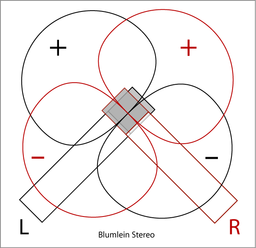In this entry we are going to recall the main techniques for stereo recording:
- Coincident microphones or intensity stereophony. It uses level differences between the two microphones, with no time differences.
- XY pair. Consists in two directional microphones at the same place with opening angles which typically go from 90 to 150º.

- Blumlein pair. Consists in two figure of eight microphones angled 90º.

- Mid/side pair, or MS pair. Employs a bidirectional (or figure-of-8) microphone pointing sideways (side, or S) plus either an omnidirectional or a variant of a cardioid microphone pointing forward (mid, or M). L and R signals can be formed by a linear combination of S and M.

- XY pair. Consists in two directional microphones at the same place with opening angles which typically go from 90 to 150º.
- Spaced microphones, time-of-arrival stereophony or AB technique. This techique consists in having two omnidirectional microphones separated a distance which goes from a few tenths of cm to a few meters. Signal levels are mostly the same, at least with small separations, and stereophony is due to time-of-arrival differences only.

- Near coincident pair techniques, the most common of which is the ORTF system. It consists on two cardioid microphones opened 110º and spaced 17 cm.

By checking some references on stereo microphony, like
- Bruce Bartlett, On-Location Recording Techniques
- Wikipedia entry on Stereophonic recording methods and on Microphone practice
- Francis Rumsey, Spatial audio
- Your notes taken in class, and your experience while listening in the lab
try to answer the following questions:
- What are the advantages and incovenients of each one of the techniques?
- How is the stereo image perceived in each one of the cases?
- What kind of directivity patterns one can get with the MS technique? How to go from MS to LR signals?
- Is it always the optimal thing to place two microphones near the stage in the approximate positions the playback loudspeakers would be? Why?
Also, there are microphone configurations directly suitable for recording directly in 5.1 stereo surround. See for instance:
- Francis Rumsey, Spatial audio
- http://www.sanken-mic.com/en/qanda/index.cfm/18.56
- Bruce Bartlett, On-Location Recording Techniques
Surround sound recording techniques are based on the same principles (summing localization — time and/or intenisty differences). They try to capture the main soundstage in the L, C, R channels and leave ambience and reverberation for Ls and Rs. In general, listening to surround sound reduces the stereo separation because of the center channel, and surround recording techniques try to counteract this effect.